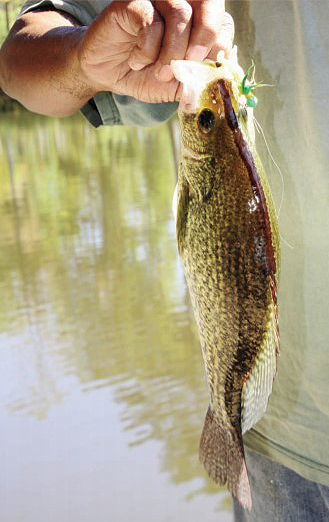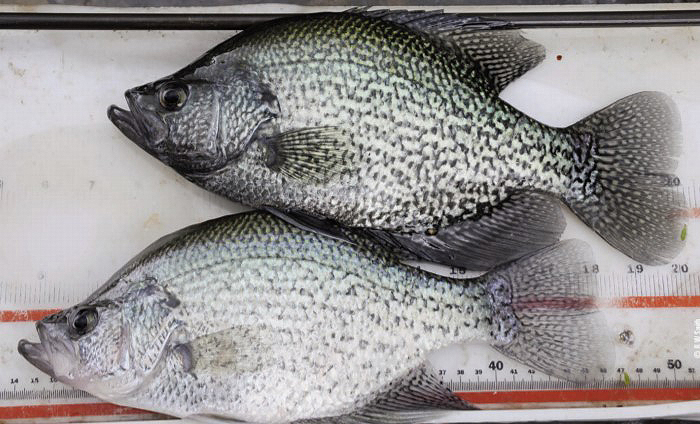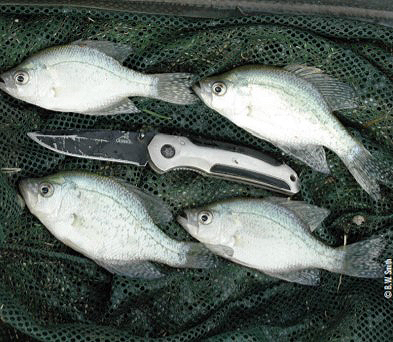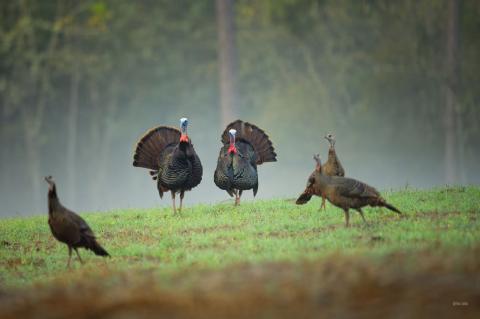Barry W. Smith | Originally published in GameKeepers: Farming for Wildlife Magazine. To subscribe, click here.

breeds true is the black nose crappie, shown
here with the characteristic black stripe from the
dorsal fin to the nose. American Sport Fish
produces this variety of black crappie. This
marker is helpful in many public water stockings
to identify the impact of a stocking program.
Crappie can be fun to catch and even better to eat. Most anglers will agree, they are at the top of the list for excellent table fare. Why can’t I have them in my pond? We are going to explore some of the paradigms of stocking crappie in ponds and lakes and let you know why some lakes provide better crappie fishing than others.
Your lake is not big enough
How can this be true, most of us have fished small ponds, less than 5 acres, that have provided excellent crappie fishing along with good bass and bream fishing? The size and depth of the pond or lake has less to do with crappie success than the structure of the existing fish population and how the crappie were stocked.
Crappie are often introduced into new ponds or lakes by the owner or some of the owner’s “friends” as adult fish. “Joe and I were on our way back from crappie fishing on the river and had 20 really nice crappie in the live well so we stocked them in your lake. You should have great crappie fishing next year.” This well-intended action often is the recipe for disaster. Adult crappie typically spawn at least a month before largemouth bass spawn. The crappie fry or fingerlings get too much of a head start for the bass that are spawned the same spring to eat them and thus control their numbers. In this situation, crappie quickly over populate and their growth stunts to a size of about 4 to 5 inches by the end of the first year. This consequently affects the growth of both bass and bluegill resulting in poor fishing for many years.
Deep clear lakes are best for crappie
Many think that deep clear lakes with standing timber are ideal crappie lakes. This is not necessarily true. Fertile lakes with a variety of forage species and a varied size structure are best for crappie, providing food for growth of both adult and fingerling crappie.
Stocking crappie
Adult crappie should never be stocked into new or existing lakes. The spawning and survival of the crappie spawn is very unpredictable. As fishery biologists and lake managers, we prefer to have some control of the numbers of crappie that are stocked into each lake. Fall and winter stockings of 3- to 4-inch fingerlings is the most predictable approach. Crappie stocking rates depend on each lake’s forage base, fertility and bass structure. We prefer to introduce crappie into lakes that have a history of good bass reproduction and that actually have a fall carry over of small bass in the 4 to 6-inch range. These small bass spawned from the previous spring can help control the numbers of crappie that survive from natural spawns and help prevent overpopulation. Lake forage bases that contain minnows, such as fatheads and/or shiners, provide additional food for crappie. Lakes containing established populations of threadfin shad provide excellent food for crappie, both adults and fingerlings.
Fingerling stocking rates may vary from 25 to 100 per acre depending on the individual lake and its food base. The greater the fertility the more crappie it will support. Fingerling crappie stocked during the fall will rarely obtain sexually maturity the following spring. If crappie fingerlings are stocked during the spring; they will often achieve sexually maturity the following spring. Thus they will need small bass during Feb. and Mar. to control the numbers of crappie fry spawned. These small predators help prevent overpopulation.

Types of crappie
There are two species of crappie, black and white. These do not normally spawn together or hybridize, as in nature they often occupy different habitats. Black crappie are often found in clear lakes and reservoirs while white crappie are often found in riverine environments and turbid lakes. Black crappie seem to be more adaptive in small ponds and manmade lakes. There is a difference in the average number of spiny dorsal rays between the two species, although the range can overlap, but color patterns often work well for identification.
The black crappie has a mottled appearance, with dark specs on the side. The white crappie has more of a vertical barring on the side. The males of both species may appear dark during the breeding season, with fins appearing black and very dark coloration on the jaw and cheek plate. Many anglers mistake the dark males as black crappie and the lighter females as white crappie. This phenomenon is known in the scientific world as sexual dimorphism. When observed during the summer, fall and early winter, both sexes appear the same color.
There is also a genetic variety of the black crappie that is called the “black nose”. This variety has a black streak about the width of a Magic Marker that runs from the dorsal fin to the nose and under the jaw. It is a genetic marker that breeds true. Growth rates and spawning are the same as the regular black crappie. American Sport Fish produces black nose crappie for small lake stockings and for some governmental stockings of public waters. It is easy to identify the survival of stocked fingerlings through this obvious genetic mark.
Growth rates

in many lakes and ponds. It usually takes two years for
crappie fingerlings to grow large enough to enter the catch.
Fingerling crappie that are stocked as 3 to 4 inches in the fall will grow to 7 to 9 inches in a year. Depending on the food supply, these could be 10 inches by year two and large enough to enter the catch. I have seen crappie in small pounds larger than 2 pounds. Conversely, in ponds stocked with adult crappie, I have observed growth as slow as 6 to 7 inches in three years, because of overpopulation.
Spawning
Typically, crappie are cyclic spawners and do not necessarily spawn each year. There could be no spawning or light spawning and then a heavy spawn every three to four years. Spawning success is difficult to predict. This is unlike largemouth bass, which usually spawn well each year.
Crappie may be sexually mature at 6 inches and will usually spawn near rocks or logs around the pond banks during March and April. This is also when most crappie are caught in small ponds and lakes. During the remainder of the year, crappie will be located near structure in deeper water. They can be found on this type of structure during the middle of the summer or during the fall and winter. Most anglers have a problem locating these schools of crappie once they move off the banks.
Crappie only ponds
It is possible to establish small lakes or ponds that have crappie only, with no bluegill or bass. Landowners that have multiple ponds will sometimes stock a pond for crappie fishing only. We prefer to stock these ponds with a combination of fathead minnows, golden shiners and threadfin shad and allow the forage to build for a summer before stocking fingerling crappie during the fall. There needs to be a predator in this system to help reduce crappie reproduction and prevent overcrowding. We prefer to use hybrid striped bass as the predator instead of largemouth bass. The largemouth bass will spawn each year and soon significantly reduce the food for the crappie. Hybrid striped bass do not spawn in pond environments and thus by stocking a few each year we can control their numbers.
Is your pond a candidate for crappie?
Not all ponds are candidates for crappie stocking. Remember that for each predator you add, less food is available for the growth of your largemouth bass. I hope this article gives you some insight into the proper procedure for stocking crappie and some of the requirements needed to achieve good crappie fishing.































